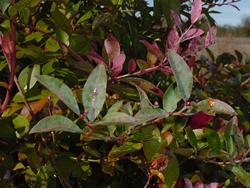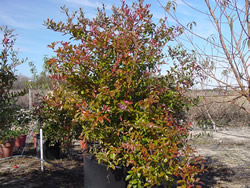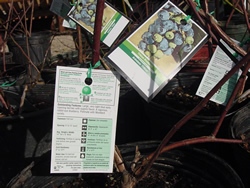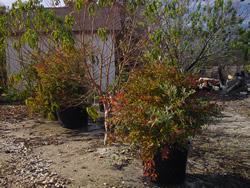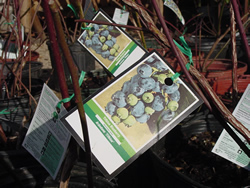|
Blueberries for Texas Berries, berries and more berries. . . . Texas is indeed a land of berries. From trailing dewberries in Central and South Texas to huckleberries in the acid soils of East Texas, there are many adaptive berries for the erratic, and environmentally-challenging growing conditions of our large state. The most planted and adapted berry planted to date has been the blackberry. However, blackberry thorns and the biennial nature of the plants makes even them a challenge in a small landscape setting. Hence, there may be an opportunity for a different berry to become "King of the Hill". The berry which comes to mind is the blueberry. Blueberries are a very popular fruit in the United States because of their unique flavor, small edible seeds, and ease of preparation. Blueberries can be eaten fresh or used for jelly, jam, pies, pastries, or juice. Blueberry fruit is also low in calories and sodium, contains no cholesterol, and is a source of fiber. A major constituent of the fiber is pectin, known for its ability to lower blood cholesterol. Blueberries contain measurable quantities of ellagic acid, which has inhibiting effects on chemically induced cancer in laboratory studies. Blueberry juice also contains a compound that prevents bacteria from anchoring themselves to the bladder, thereby helping to prevent urinary tract infections. Obviously, such great fruit attributes would make any homeowner long to culture blueberrie. Still the production of blueberries has a few challenges of its own. The soil or growing medium pH is critical for successful blueberry culture. This funny expression-- pH -- is a measure of the hydrogen ion concentration in the soil solution or simply put, whether the soil is acid (less than 7.0) or alkaline (7.1 and above). Rabbiteye blueberries are one of the few crops that require very special soil or growing medium; a pH of 4.0 to 6.0 is required for good plant growth; the plants will not live in soils or potting mixes with a pH above 5.5. The plants' feeder roots are very close to the surface and they do not have root hairs; therefore, good soil moisture management and mulches will be needed. One may be surprised as to why we would recommend such an exacting, low soil pH plant for planting across a state which only has a small amount of such soil, which is mainly in East Texas. Simply put, it is because of the potential to produce an acceptable amount of fruit on a containerized plant with very few pest problems.
Sure there are some insects and diseases which bother these plants, but if the plants are maintained in a healthy state of growth, few if any pest applications will be needed and a good quantity of fruit will still be produced. Blueberries are relatively small plants and can be protected with plant covers if bird or insect pests become a problem. Since, few of us will have soil which will be conducive to blueberry culture in the soil, we will assume that all will grow them in containers. The plants should be planted in a well-draining whiskey barrel size (20-30 gallon) container. Adequate drainage is a key to success. A soilless peat-base mix which drains rapidly should be used. Ideally, when you pour water around the base of a plant, water should soon be coming out of the bottom of the container. This not only indicates proper drainage but also enables leaching of fertilizer salts which, if accumulated, can damage a blueberry plant's roots. Soilless mixes should be soilless-- absolutely no soil! Regardless of how wonderful you think your soil is, when soil is put in a container it loses many of its beneficial qualities. Many suitable types of soilless peat-base mixes are commercially available. A soilless peat-base mix should be disease and weed-free, retain adequate moisture after watering yet is well-drained and lightweight. Essentially you will have created an "acid bog" with peat-base potting mix to assure good growth. Blueberries thrive in 100 percent peat moss, so there is no limit to the amount you can use and if you are doubtful about the pH of the potting mix you plan to use, simply add more peat moss. Be sure to incorporate a slow release fertilizer such as Osmocote into the peat-base potting mix . Avoid the use of rapid-release, nitrate fertilizer and use an acid-based, water soluble fertilizer once a month during the growing season after the plants are established. Once you have formulated or purchased a well-drained soilless peat-base mix in which to grow the blueberry plant, be sure that the container being used has adequate drainage capabilities. If a water-tight container is being used, drainage holes will have to be drilled. When considering drainage holes, the old saying, "The more, the merrier" definitely applies. Also, don't worry about lining the bottom of the container with course gravel or charcoal to expedite drainage. Recent research indicates that such a gradient in materials actually impedes drainage. If a loose soilless mix is used, water drainage through drain holes will not be a problem. The taller the container, the more difficult it is to obtain even water distribution. The half whiskey barrels or 20 - 30 gallon size containers are your best bet. Heavy duty coasters can be attached to the bottom of the containers before potting mix is added to allow ease of movement even though blueberries will not have to be protected from cold weather--they require cold weather in order to fruit. Another critical key to successful blueberry production is sunlight. All berries require full sunlight all day for maximum production. Minimum is eight to ten hours of direct (not filtered) sunlight a day. Not only do the plants require full sunlight when they are planted, but also as they continue to grow. Over time if they become shaded by trees in your landscape, their production will be much less. Some blueberry varieties require cross pollination so variety selection will be critical. However, Tifblue has been shown to be self-fruitful and is the most universally outstanding rabbiteye blueberry grown to date. The fruits are large, light blue and ripen late in the season. The bush is vigorous and very productive. Tifblue is more cold hardy than most rabbiteye blueberries varieties and receives adequate chilling (cold temperatures) to fruit as far south as Pleasanton, Texas. Tifblue rabbiteye blueberries require little pruning. Lower limbs can be thinned out to keep the fruit from touching the soil, and excessively vigorous upright shoots can be thinned out several feet from the ground to keep the center of the bush open and to keep the bearing surface within reach. Spindly, weak, or dead branches should be thinned out annually during the dormant season. Blueberries have a very fine and fibrous root system so mulching is a must as well as frequent irrigation. Use some sort of organic mulch such as spaghum peat moss but avoid the manures since most are alkaline and salty. Because culturing plants in containers severely limits their root spread, frequent watering and fertilization are essential. As emphasized earlier, the well-drained soilless peat-base mix--necessary for good aeration--needs frequent watering. As plants grow larger, more watering is required because water is being absorbed and transpired. As temperatures increase more water is evaporated from the mix and transpired from the plant. Young plants growing in cool weather may require watering only once every two or three days. Check the moisture level of the mix with your finger before watering, i.e., water the mix, not the plant. If you feel moisture with your finger DO NOT WATER; more plants are killed by over watering than by being too dry. Remember, container size and soilless peat-base mix used will have a lot to do with the watering regime followed. Blueberries also require good-quality water with low sodium and bicarbonates. It would be best if you could use rainwater or air-conditioner condensate for irrigation as most of the water across the state is high in salts especially calcium. Water large plants thoroughly once per week rather than daily and keep a deep layer of mulch around the plants. Water is especially important during the long fruit-ripening period. Rabbiteye blueberries are a non-climacteric fruit and should be allowed to ripen on the bush. The fruit of the Tifblue variety will ripen over a 4 to 6 week period. A normal season can extend from late May to late July. Don't pick the berries until they are fully ripe; otherwise the fruit will be bitter. Once the berries begin to ripen they should be picked every 3 to 5 days.
Birds seem to be the key wildlife competitors for the delicious fruit. A mature bush can produce 15 lbs of berries. So now you know the "secrets" of successfully producing one of the most delicious and health-giving fruits, blueberries, in regions which were previously considered off-limits to these acidic soil loving delicacies. These same growing techniques should be used when growing other acidic-loving plants such as azaleas, camellias and gardenias in alkaline soil areas. However, these flowering plants thrive in a growing exposure which receives morning sun and afternoon shade. For videos about this procedure, see: Growing Acid Loving Plants and | |
|
Prepared for Web delivery 9 March 2005. http://aggie-horticulture.tamu.edu/plantanswers/publications/blueberries/blueberries.html | |
| PLANTanswers Publications | PLANTanswers Index | Aggie Horticulture |
